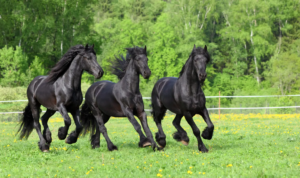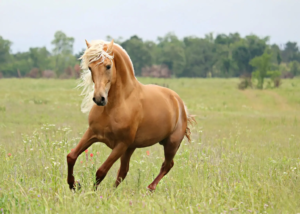America’s Iconic Breed
In the heartlands of America, amidst the dust of ranches and the thunder of hooves, stands a breed synonymous with versatility, agility, and the spirit of the West—the American Quarter Horse. Renowned for its speed over short distances and its steady temperament, this breed has captured the imagination of equestrians worldwide. Let’s delve into the fascinating world of the American Quarter Horse, exploring its history, characteristics, and enduring legacy.

History and Origins
The American Quarter Horse, often simply called the “Quarter Horse,” traces its lineage back to the early colonial days in America. Bred primarily in the southern states, its ancestors include English Thoroughbreds imported to the New World in the 1600s, as well as Spanish horses brought over by Conquistadors. These horses were crossbred with local indigenous horses, resulting in a sturdy, agile breed capable of sprinting short distances—typically a quarter mile, hence the name “Quarter Horse.”
By the 19th century, the breed had become a favorite among cowboys and settlers in the American West. Its ability to work cattle, sprint at incredible speeds, and maintain a calm demeanor under pressure made it invaluable on ranches and in the rodeo arena. The American Quarter Horse quickly earned a reputation as the quintessential Western horse, embodying the rugged spirit and hard-working ethos of the American frontier.

Physical Characteristics
The Quarter Horse is characterized by its muscular build, compact frame, and powerful hindquarters. It stands between 14 to 16 hands high (56 to 64 inches at the shoulder) and comes in a variety of colors, including bay, sorrel, black, and palomino. One of the breed’s distinctive features is its expressive, intelligent eyes set within a refined head.
The breed’s athleticism is further emphasized by its deep chest, strong shoulders, and short, strong back. This conformation allows for quick bursts of speed and agility, making it well-suited for activities such as barrel racing, cutting, reining, and roping—sports where speed, agility, and responsiveness are paramount.
Versatility and Modern Role
While the Quarter Horse’s roots lie in ranch work and sprint racing, its versatility has seen it excel in a wide range of disciplines. From Western pleasure and trail riding to dressage and even therapeutic riding programs, Quarter Horses consistently prove their adaptability and reliability. Their gentle temperament makes them suitable for riders of all ages and abilities, from novice enthusiasts to seasoned competitors.

In addition to their performance in various equestrian sports, American Quarter Horses are also valued for their role in leisure riding and as trusted companions. Their calm, friendly nature and willingness to work with humans make them cherished partners both in the arena and on the trail.
Conclusion
In conclusion, the American Quarter Horse stands as a testament to America’s equestrian heritage and the enduring legacy of the Wild West. Whether thundering across the prairie in pursuit of cattle or gracefully navigating an intricate dressage pattern, this breed continues to capture the hearts of horse lovers around the globe. Its combination of speed, versatility, and gentle disposition ensures its place not only in history books but also in the stables and arenas where its spirit shines brightest.
For those who admire the beauty and functionality of these remarkable animals, the American Quarter Horse represents not just a breed, but a symbol of the enduring bond between humans and horses—a bond forged in the dust and sweat of America’s frontier days and celebrated in arenas and pastures alike today.
